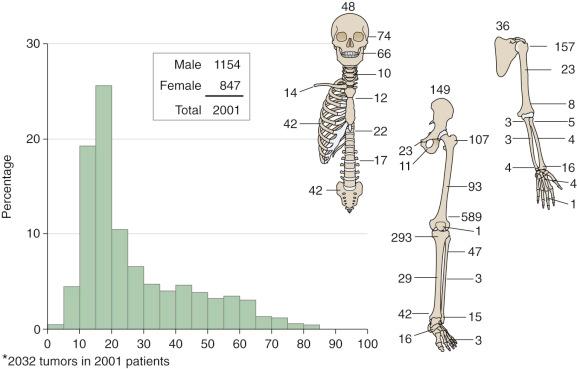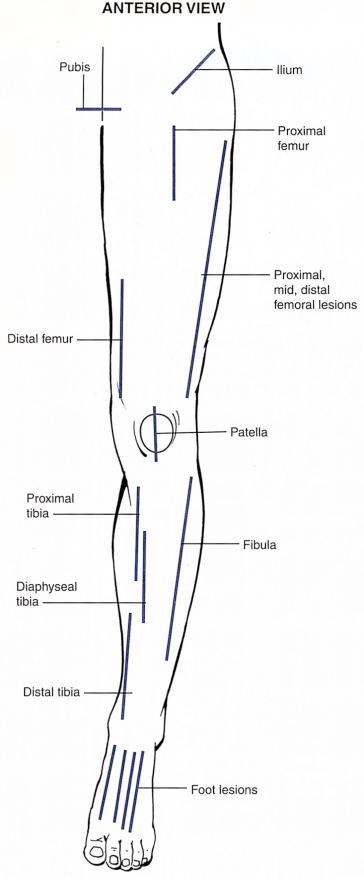Physical Address
304 North Cardinal St.
Dorchester Center, MA 02124
Primary malignant tumors about the hip are rare.
Early recognition is critical in curative treatment.
Chemotherapy or radiation may be indicated, depending on histology. Durable limb salvage techniques are applicable to most patients.
Primary malignant processes frequently present in the hip region. Prompt recognition of these patients is critical, as a window for cure often exists. These lesions are treated with resection with or without adjuvant therapies, depending on histology. With few exceptions, wide surgical resection of all disease is required for long-term survival. Limb salvage procedures are possible in 85% to 90% of cases, and modern techniques provide durable prosthetic reconstructions. This chapter will address the treatment of primary bone and soft tissue sarcomas about the hip.
Although sarcomas can present in any age group, classic patterns have been observed and documented. Osteosarcoma is the most common bone sarcoma, with the best characterized epidemiology. Approximately 500 cases per year arise in the United States. Although mutations in the retinoblastoma gene (hereditary retinoblastoma) or p53 gene (Li-Fraumeni syndrome) can lead to osteosarcoma, most cases arise sporadically.
Data from more than 2000 cases of osteosarcoma treated over a 100-year period highlight the presentation of this tumor ( Fig. 50.1 ). Males account for a modest majority of cases, and most patients are in the second or third decade of life. The hip region (including proximal femur and pelvis) is the second most common site of disease after the knee. The skeletal distribution of osteosarcoma roughly parallels the amount of skeletal growth at various sites.

Other sarcomas have similar distributions. Chondrosarcoma and Ewing sarcoma are the next most common primary bone tumors about the hip. Chondrosarcoma arises in an older patient population (typically middle-aged and elderly) than osteosarcoma and most commonly involves the pelvis or proximal femur region. Ewing sarcoma shows a similar age distribution to osteosarcoma but has more tumors in the hip and pelvis region. Extraabdominal soft tissue sarcomas present in middle-aged to older adult patients, with the thigh and buttock regions being the most frequent sites of disease. Although true bony invasion is rare, these tumors may encase the sciatic nerve or femoral artery and often abut the bone directly.
Patients presenting with a primary malignant tumor about the hip joint require accurate diagnosis and staging for proper management. Staging involves defining the local and systemic extent of disease. Local imaging begins with plain radiographs of the affected area (even for patients with soft tissue sarcomas). Patients with bony tumors should undergo imaging of the entire femur and pelvis to identify any discontiguous sites of disease (skip lesions). Magnetic resonance imaging (MRI) is used to characterize marrow involvement and soft tissue masses or extensions. Select tumors may require computed tomography (CT) angiography to define vascular invasion or encasement.
The systemic extent of disease is evaluated with CT of the chest and bone scintigraphy (for bony tumors) to complete oncologic staging. Although CT of the abdomen and pelvis is not part of routine oncologic staging for extremity sarcomas, we employ this approach in any patient whose primary tumor involves the pelvis or extends above the inguinal ligament to detect any regional metastases that might be missed with imaging of the chest and tumor site alone. The role of positron emission tomography (PET) is currently evolving in the staging evaluation of primary tumors. Fluorodeoxyglucose (FDG)-PET is currently less sensitive than chest CT to detect early pulmonary metastases but is likely more sensitive to detect extrapulmonary metastases. As the sensitivity of PET is influenced by the intrinsic metabolic activity of the tumor, it is an excellent imaging modality for high-grade tumors (e.g., Ewing sarcoma) but is not reliable for low-grade tumors (e.g., low-grade chondrosarcoma), which have less metabolic activity. Select histologies (e.g., myxoid liposarcoma) may have specific additional staging protocols.
Although many lesions have a characteristic appearance on imaging studies, biopsy is generally needed to establish diagnosis before malignant conditions are treated. We generally use image-guided (fluoroscopic, CT, or ultrasound [US]) core needle biopsy as the first-line invasive sampling method for tumors. High diagnostic accuracy is seen in the hands of experienced pathologists. Open biopsy is reserved for unsuccessful core needle biopsy. The biopsy approach, whether open or percutaneous, should be carefully planned to target high-yield areas of the lesion and to allow excision of the biopsy tract and any contaminated tissues at the time of definitive resection. A poorly planned biopsy can severely compromise ultimate patient outcomes. In the case of open biopsy, transverse incisions are never used, and care is taken to split individual muscles rather than open classic planes to minimize the zone of biopsy site contamination. Traditional limb salvage incisions are shown in Fig. 50.2 ; it is strongly recommended that the biopsy path be planned with an oncologic surgeon. Unfortunately, major errors in biopsy placement and execution persist.

Adjuvant chemotherapy and/or radiation therapy is the standard of care in high-grade primary bony malignancies. Chemotherapy improves the survival of patients with localized Ewing sarcoma and osteosarcoma from approximately 10% to approaching 70% or greater. Additionally, long-term disease-free survival may be seen even in patients with limited metastatic disease treated with aggressive surgery and chemotherapy. Essentially all standard regimens for these tumors employ 2 to 4 cycles of chemotherapy preoperatively. Surgical resection is accomplished with a minimal delay in therapy, followed by multiple postoperative cycles of additional chemotherapy.
The critical nature of chemotherapy in these diseases highlights the importance of an accurate initial diagnosis before therapy commences. The chemotherapy response as assessed by the necrosis seen in the resected tumor specimen is predictive of overall survival. However, upfront surgery followed by an equivalent total number of postoperative chemotherapy cycles yielded identical clinical outcomes in the only prospective randomized study that directly examined this regimen.
Radiotherapy may be used in the treatment of Ewing sarcoma and is commonly used in the treatment of soft tissue sarcoma. High-dose radiation can be used in place of surgery for local control in Ewing sarcoma when resection is not possible or practical. Although no prospective randomized studies have compared surgery versus radiotherapy for local control in Ewing sarcoma, available data appear to indicate that surgery or surgery combined with radiation may be superior to radiation alone. Additionally, significant long-term complications are seen following radiation for femoral Ewing sarcoma. In contemporary practice, surgery is used in the management of nearly all patients with femoral Ewing sarcoma. Radiation is added to this in the case of a marginal resection (e.g., along major neurovascular structures) or in the case of poor chemotherapy response. The local control of pelvic Ewing sarcoma remains individualized, with a number of patients treated with definitive radiotherapy given the morbidity of surgical management.
Local control of soft tissue sarcomas is improved with the use of radiotherapy. Radiation for soft tissue sarcomas may be administered preoperatively or postoperatively and has been examined in a prospective randomized study. Preoperative therapy engenders a higher wound complication rate but allows a lower dose to be administered to a smaller volume of tissue. Although initial wound complications are more frequent with preoperative therapy, long-term limb function appears better as the result of less ultimate edema and fibrosis. The use of preoperative versus postoperative radiotherapy is often influenced by institutional practice patterns and specific patient situations.
Use of chemotherapy for soft tissue tumors is best considered investigational. Multiple studies (most retrospective) have found conflicting results, and a high-quality meta-analysis revealed modest survival benefits in patients with high-grade tumors. Relatively few studies of chemotherapy in soft tissue sarcoma are “clean”; most mix patients with different histologies and use varying treatment regimens. Just as the results of chemotherapy for bone sarcoma would be difficult to interpret if osteosarcoma, chondrosarcoma, and Ewing sarcoma were grouped together, interpretation of chemotherapy results for soft tissue sarcoma is nuanced and complex. Chemotherapy for these conditions is best given under the advice and management of an experienced sarcoma oncologist in a clinical trial until further data are available.
Patients in whom soft tissue tumors are excised with a subperiosteal margin and who receive radiation have a high risk of subsequent femur fracture and may benefit from prophylactic fixation. This usually is not done at the time of tumor resection to avoid increasing the magnitude of an already complex procedure and because of the high rate of wound healing complications and potential infection. Patients can be allowed to recover from the initial surgery with final margin status assessed and wound or flap healing accomplished before prophylactic nailing is done.
Amputation remains relevant to current sarcoma management. Amputation should be strongly considered if a proper oncologic margin cannot be obtained or if the function following resection would be inferior to that of an amputation. Amputation is also considered after pathologic fracture or poorly planned biopsy.
Become a Clinical Tree membership for Full access and enjoy Unlimited articles
If you are a member. Log in here